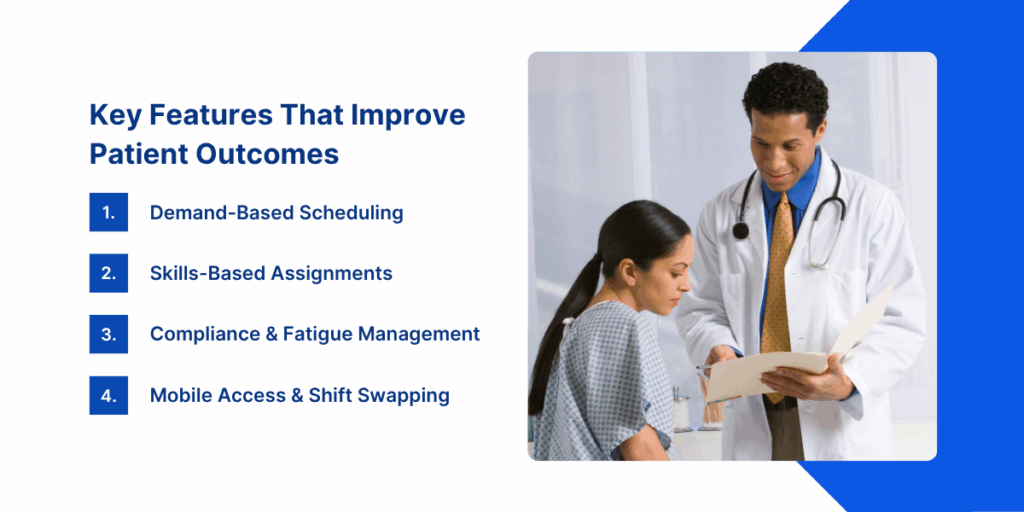With tight margins, labor shortages, and growing regulatory pressure, nurse managers face a critical challenge: ensuring the right staff are in the right place at the right time—without causing burnout.
Traditional scheduling approaches are no longer enough. The ripple effects of understaffed units, excessive overtime, and scheduling confusion aren’t just operational—they’re clinical. Patient outcomes suffer when staff are stretched too thin.
This is where smarter nurse scheduling software comes into play. By leveraging automation and real-time data, healthcare organizations can align labor strategy with clinical priorities, boosting both efficiency and the quality of patient care.
The High Stakes of Nurse Scheduling
When hospitals rely on spreadsheets or manual scheduling system, the result is often chaotic. Nurse managers spend hours juggling requests, coverage gaps, and compliance rules. These inefficiencies contribute directly to avoidable costs and preventable harm. Overworked nurses are more likely to make mistakes, experience burnout, or call off at the last minute, creating a reactive staffing environment.
Research consistently shows a link between nurse staffing levels and patient outcomes. A 2021 Lancet study found that higher nurse-to-patient ratios were associated with lower in-hospital mortality. With so much at stake, it’s critical that healthcare leaders prioritize better scheduling tools that reduce variability and support consistency in care delivery.
What Is Nurse Scheduling Software?
Nurse scheduling software is a digital solution that automates the process of creating, managing, and optimizing nurse shift schedules. Unlike static tools such as Excel or paper-based systems, modern nurse scheduling software provides dynamic capabilities like:
- Automated shift generation based on rules and demand forecasts
- Real-time visibility into staffing levels across units or locations
- Skill and credential-based scheduling to ensure proper nurse-to-patient alignment
- Mobile access for schedule viewing, shift swapping, and call-off requests
By streamlining the entire scheduling workflow, nurse scheduling software helps organizations respond quickly to staffing changes, reduce administrative burden, and provide a more equitable work experience for staff.

Key Features That Improve Patient Outcomes
The best nurse scheduling software platforms are built not just for convenience but for outcomes. Here’s how key features drive better care delivery:
1. Demand-Based Scheduling
Predictive algorithms enable managers to align staff levels with anticipated patient volume and acuity trends. By forecasting demand based on historical patterns and internal scheduling data, nurse scheduling software helps prevent both overstaffing during slower periods and critical gaps during peak times. This balance ensures nurses are neither underutilized nor overworked, which contributes to more consistent patient care and better staff morale.
Instead of relying on static schedules or reactive decision-making, Indeavor enables healthcare organizations to proactively adjust labor plans in advance of expected fluctuations. Through configurable business rules and demand-based templates, nurse managers can create flexible schedules that match labor needs with operational goals—without the guesswork. This leads to smarter resource allocation and fewer last-minute staffing emergencies that can compromise patient outcomes.
2. Skills-Based Assignments
Not all nurses are interchangeable. Different units require specialized training, certifications, and experience levels that must be accounted for when creating schedules. Nurse scheduling software allows managers to filter and assign shifts based on skills, ensuring that staff working in areas like the ICU, emergency department, or neonatal care have the appropriate credentials. This level of precision reduces the risk of skill mismatches that can compromise patient safety.
By automating this process, the software eliminates manual cross-checking and guesswork, giving nurse managers confidence that every shift is staffed appropriately. It also supports compliance with regulatory and accreditation standards by maintaining up-to-date records of staff competencies and ensuring only qualified individuals are scheduled in roles that match their training. The result is not only better clinical outcomes but also improved team trust and performance.
3. Compliance and Fatigue Management
Healthcare is one of the most heavily regulated industries when it comes to labor. From staffing ratios to union contracts, scheduling must adhere to complex policies while still ensuring operational efficiency. Nurse scheduling software automates the enforcement of these rules, reducing legal risk and administrative overhead.
Fatigue is often a hidden threat in healthcare. Nurses working back-to-back shifts or excessive overtime are more prone to errors. By avoiding excessive overtime and strategically filling open shifts, hospitals can improve coverage without inflating payroll. Scheduling software can automatically enforce rest periods and track hour limits to prevent unsafe scheduling practices. The result is cost containment without compromising care.
4. Mobile Access and Shift Swapping
Empowering nurses to manage their schedules through mobile tools improves engagement, autonomy, and overall satisfaction. With nurse scheduling software, staff can view their schedules in real time, submit time-off requests, and indicate shift preferences—anytime, from anywhere. This level of accessibility eliminates the need for manual tracking or paper-based processes, streamlining communication between nurses and their managers.
Additionally, built-in shift swap functionality allows staff to easily exchange shifts with qualified peers, subject to manager approval and compliance rules. This self-service capability reduces the administrative burden on schedulers while giving nurses more control over their work-life balance. Fewer unplanned absences and increased schedule transparency ultimately lead to more reliable coverage and improved continuity of care.

Measurable Benefits for Hospitals and Health Systems
Smarter scheduling isn’t just about operational gains, it translates into measurable clinical and financial results. Organizations that implement intelligent nurse scheduling software often see:
- Lower absenteeism and voluntary turnover: When nurses have more control and transparency, job satisfaction improves.
- Reduced overtime and premium pay: Automated scheduling fills shifts efficiently without costly last-minute incentives.
- Higher patient satisfaction scores: Consistent, well-rested staff provide better care and communication.
- Improved regulatory compliance: Automated rule enforcement minimizes scheduling errors that could trigger audits or penalties.
Healthcare leaders need solutions that go beyond digitizing the status quo. Indeavor’s nurse scheduling software empowers nurse managers and staff alike, creating a sustainable workforce strategy that supports both the caregiver and the patient.
How Indeavor Supports Smarter Nurse Scheduling
Indeavor offers a purpose-built workforce management platform that redefines how healthcare systems schedule their nursing staff. With deep experience in complex labor environments, Indeavor’s nurse scheduling software delivers:
- Integration with existing HRIS, EHR, and timekeeping systems
- Real-time scheduling dashboards for nurse managers
- Centralized rule enforcement for compliance with internal policies and regulations
- A mobile-first experience for nurses to interact with their schedules anytime, anywhere
Whether you’re managing one hospital or a multi-site system, Indeavor provides the visibility, control, and automation needed to optimize nurse scheduling at scale.
Conclusion
Patient outcomes are influenced by a variety of factors, but staffing is foundational. Smarter scheduling ensures that the right nurse, with the right skills, is available when needed most. In a high-stakes environment, every decision counts. Scheduling software from Indeavor helps hospitals take the guesswork out of scheduling and replace it with real-time, data-driven precision.
Ready to modernize your nurse scheduling strategy? Schedule a demo to learn how Indeavor’s solution can transform your workforce planning and elevate care outcomes.
About the Author
Claire Pieper is the Digital Marketing Specialist for Indeavor. In her role, she specializes in crafting strategic and engaging content, ensuring that customers are well-informed. Claire is dedicated to enhancing the customer experience and optimizing the user journey through Indeavor’s solutions. To learn more or get in touch, connect with Claire on LinkedIn.



